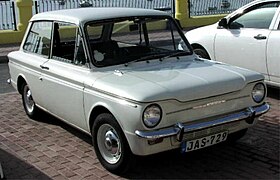Commer Express Delivery Van
| Hillman Imp | |
|---|---|

Hillman Imp 2-door saloon
|
|
| Overview | |
| Manufacturer |
Rootes Group (1963-1967) Chrysler Europe (1967-1976) |
| Also called | Hillman GT (Australia) Hillman Husky Commer Imp Van Singer Chamois Sunbeam Imp Sunbeam Sport Sunbeam Chamois Sunbeam Stiletto Sunbeam Californian Sunbeam 900 |
| Production | 1963–1976 440,032 made |
| Assembly |
Linwood, Scotland Australia Costa Rica Ireland Malaysia Malta New Zealand Philippines Portugal South Africa Uruguay Venezuela |
| Designer |
Michael Parkes Tim Fry |
| Body and chassis | |
| Class | Economy Car |
| Body style | 2-door coupe 2-door saloon 3-door estate (Husky) 3-door panel van |
| Layout | RR layout |
| Related |
Bond 875 Clan Crusader Ginetta G15 Davrian Demon/Imp BS Nymph Siva Llama Beach Mk4 |
| Powertrain | |
| Engine | 875 cc, 998 cc straight-4 overhead camshaft |
| Transmission | 4-speed manual all-synchromesh. |
| Dimensions | |
| Wheelbase | 2,082 mm (82.0 in) |
| Length | 3,581 mm (141.0 in) |
| Width | 1,524 mm (60.0 in) |
| Height | 1,385 mm (54.5 in) Saloon 1,330 mm (52.4 in) Coupe 1,475 mm (58.1 in) Hillman Husky/Commer Imp |
| Kerb weight | 725 kg (1,598 lb) |
| Chronology | |
| Successor | Chrysler Sunbeam |
The Hillman Imp is a small economy car made by the Rootes Group and its successor Chrysler Europe from 1963 until 1976. Revealed on 3 May 1963, after much advance publicity, it was the first British mass-produced car with the engine block and cylinder head cast in aluminium.
Being a direct competitor to the BMC's Mini, it used a space-saving rear-engine, rear-wheel-drive layout to allow as much luggage and passenger capacity as possible in both the rear and the front of the car. It used a unique opening rear hatch to allow luggage to be put into the back seat rest.
In addition to its aluminium engine, it was the first mass-produced British car to have an engine in the back and the first car to use a diaphragm spring clutch. The baulk-ring synchromesh unit for the transaxle compensated for the speeds of gear and shaft before engagement, which the Mini had suffered from during its early production years.
It incorporated many design features which were uncommon in cars until the late 1970s such as a folding rear bench seat, automatic choke and gauges for temperature, voltage and oil pressure.
This unorthodox small/light car was designed for the Rootes Group by Michael Parkes (who later became a Formula One driver) and Tim Fry. It was manufactured at the purpose-built Linwood plant in Scotland. Along with the Hillman marque was a series of variations including an estate car (Husky), a van and a coupé.
The Imp gained a reputation as a successful rally car when Rosemary Smith won the Tulip Rally in 1965. This led the Rootes Group to produce a special rally conversion of the Imp under both the Hillman and Singer marques known as the Imp Rallye. In 1966, Rosemary Smith after winning the Coupe des Dames, was disqualified under a controversial ruling regarding the headlamps of her Imp. The Imp was also successful in touring car racing when Bill McGovern won the British Saloon Car Championship in 1970, 1971 and 1972.
...
Wikipedia
